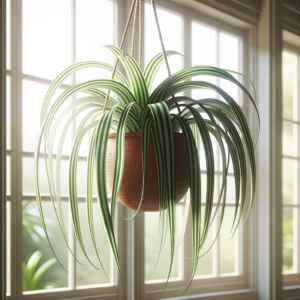Introduction

Spider plants (Chlorophytum comosum) are beloved houseplants known for their graceful, arching leaves and easy maintenance. If you’ve recently welcomed a spider plant into your home or want to ensure your current one thrives, here are some key care tips to follow:
Lighting
Spider plants prefer bright, indirect light. Place them near a window with filtered sunlight, but avoid exposing them to direct, intense sunlight, as it can scorch the leaves. Inadequate light can cause pale leaves and stunted growth.
Watering
Aim to keep the soil evenly moist but not waterlogged. Allow the top inch of soil to dry out before watering again. Overwatering can lead to root rot, while underwatering causes leaf tips to brown. Use well-draining soil and pots with drainage holes to prevent waterlogging.
Temperature and Humidity
Spider plants adapt well to average room temperatures between 65-75°F (18-24°C). They can tolerate slightly cooler temperatures but should be protected from drafts. Moderate humidity is usually sufficient, but if the air is dry, increase humidity by misting the leaves or using a humidifier.
Fertilization
Spider plants don’t require frequent feeding. During the growing season (spring and summer), use a balanced, water-soluble fertilizer at half strength once a month. Reduce or eliminate fertilization during the winter months when growth slows down.
Pruning
Regular pruning helps maintain the plant’s attractive appearance and encourages new growth. Remove yellowed or damaged leaves and trim long, trailing stems to promote a fuller shape. Spider plants are easily propagated by planting the “spiderettes” (baby spider plants) that emerge on long stems.
Pests and Problems
Spider plants are generally resistant to pests, but occasionally they may attract spider mites or mealybugs. Inspect the leaves regularly, especially the undersides, for signs of infestation. If pests are present, wipe them off with a damp cloth or use an organic insecticidal soap. Brown leaf tips may indicate underwatering or low humidity, while mushy, discolored roots may result from overwatering.
Conclusion
By following these care tips, you can ensure your spider plant remains healthy, vibrant, and a delightful addition to your indoor space. With minimal effort, you’ll enjoy the beauty of its cascading foliage for years to come.
Related Articles
Fertilization and Plants: Nourishing the Green World
Outbound Links
Wiki: Chlorophytum comosum

